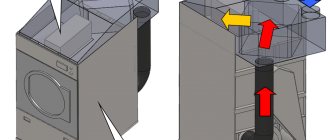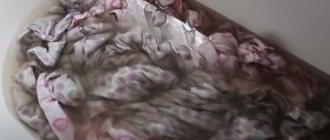Thanks to washing machines, today washing clothes does not cause sadness on the face of housewives, but becomes a pleasant experience.
This technical achievement helps to easily cope with a large amount of work, but you should not trust everything to automation. There are important criteria responsible for monitoring quality washing.
There are many brands of washing machines. Eurosoba (under-sink washing machines) is not the least of them. They are equipped with built-in washing modes that allow you to wash clothes at the desired temperature and degree of delicacy. This brand is very easy to use. It has a stylish design and a user-friendly control panel. With Eurosoba, washing becomes a pleasure.
Today there are some rules that help you load laundry into the washing machine correctly.
Sorting things
You should not throw the entire pile of laundry into the Eurosoba washing machine indiscriminately. The first step is to sort it according to several criteria:
- color (white, colored, dark)
- type of fabric (natural material, synthetic)
- type of pollution (light, heavy)
When loading laundry into the machine, there is no need to adhere to rigid uniformity. Don't fill the drum with just sheets or T-shirts. The more varied the items of clothing, the greater the likelihood that they will mix well and wash better. If you previously held this position, you should abandon it.
Some more useful tips
- Use special laundry bags - place pillowcases, sheets, and duvet covers there.
- To make things less wrinkled, reduce the spin speed. If the maximum for a particular type of fabric is 1000 rpm, set it to 800.
- Add conditioner. Thanks to it, the sheets acquire a pleasant smell and softness, and the formation of wrinkles is prevented.
- Use starch impregnation - it makes smoothing easier and prevents contamination. Regularly starched items last longer.
- Newly purchased sets must be washed and ironed.
Preparation
Next, we inspect the clothes.
- We begin to examine the pockets and make sure that they are empty. It’s sad to wash forgotten money or a flash drive with important information.
- It is recommended to turn out duvet covers and pillowcases and remove all debris that has collected in their corners.
- We look through all the clothes for the presence of pins or brooches, if any, unfasten them.
- All zippers should be zipped and buttons undone before machine washing.
- Don't forget to take off your belts.
- If you have to wash terry items, then the part on which the fur is located should be left inside.
- We turn socks and tights inside out before washing, and only then load them into the drum.
- If you wash your underwear along with your regular underwear, you must first put it in a small special bag.
You should not put powder inside the washing machine along with the laundry, otherwise its residues at the end of the wash will be neatly placed all over the laundry without being rinsed off. Washing powder is poured into a special compartment located next to the control panel.
Once the preparatory stage is completed, you can move on to subsequent actions.
Rules for loading laundry into the washing machine
- Sort things by color as much as possible.
Avoid washing light-colored items with brightly colored ones, especially those made from natural materials; they are especially prone to fading under the influence of water and detergents. - Sort things according to the quality of the material
- otherwise they may either be damaged or poorly washed, since there is no universal mode for an embroidered silk blouse and jeans made of thick classic cotton. - It is important to use bags/nets when necessary for washing delicate items and duvet covers.
This will protect delicate items and prevent small objects from getting inside the duvet cover and bunching up. - It is necessary to carefully check what is being prepared for washing for any remaining foreign objects
(coins, tissues, toys, etc.), as well as loose fasteners and loosely sewn parts - this will save both items and equipment from damage. - Everything goes into the car except bras, lace, stockings, etc., packed in a net.
should be placed unfolded (not folded or stacked). - Do not overload or underload the drum.
The last two points deserve further consideration.
Selection of machine program and detergents
The labels on the clothes will help you choose the right washing mode. It depends on them to what temperature the water will heat up and how intensively the spin will occur. If they are not there, then you can follow the following general recommendations:
- If the items loaded into the drum are predominantly made of synthetic fabrics, then they should be washed at a temperature reaching fifty degrees, with a maximum number of revolutions of nine hundred.
- If things shed, then the water should not heat above thirty degrees.
- Colored cotton underwear can be washed in water heated to sixty degrees; the spin speed can be set to the full maximum. They won't spoil.
- When it comes to fabrics such as silk, this is necessarily a delicate wash, in which the water temperature is only forty degrees, and the speed mode is set to minimum.
As for the choice of detergents, but under no circumstances use powder intended for hand washing - this may damage the washing machine. Which washing powder will be used depends on the material of the products that will be washed and the type of contamination. There are two types:
- water-soluble, which includes sweat or salt;
- insoluble in water - sand, fat.
A separate group consists of pigment spots from coffee or wine. To get rid of them, the laundry will need to be bleached.
How to wash clothes made from different fabrics?
The type of fabric determines at what temperature and speed the process should be started and how long it should last. For the manufacture of bedding sets the following is used:
- Cotton;
- Satin;
- Calico;
- Linen;
- Polyester;
- Silk;
- Velvet.
If you don't have SMA, it's very important to know at what degrees a particular tissue wears out. It’s good when you can entrust the choice of temperature to the machine - just select the desired program on the control panel, and the appropriate parameters will be set automatically.
Made from cotton
It is recommended to hand wash a new cotton set in cool water. Subsequently, the temperature is selected depending on the contamination and color:
- For white, select the “cotton” mode, temperature - 60 degrees;
- If things have acquired a grayish tint - 90-95 degrees;
- If there are stubborn stains, start pre-soaking and add bleach to the container;
- Colored clothes are washed at 40 degrees - this is enough to wash cotton without losing the brightness of its color.
Cotton is not loaded together with synthetics - synthetic fibers cling to softer, natural fibers, making the fabric less pleasant to the touch. Cotton is dried outside, inside out. There should be no direct rays - they do not have the best effect on the fabric. Cotton items should be ironed slightly under-dried. The ironing side is the front side, embroidery is ironed from the wrong side.
Little secrets of successful washing
- Keep your laundry in order. It is very important that there is a little space between it and the drum, this contributes to high-quality washing and the machine will not break. Washing machines
have a drum capacity of up to 3 kg, they are easy to use and guarantee high-quality washing results. If you need a larger volume of washing, we advise you to pay attention to small-sized washing machines with increased capacity Eurosoba - compact washing machines.
- Light tulle or lace curtains can be safely trusted to the washing machine if the drum is filled halfway.
- There is no need to put laundry in a big pile. Place large items in the drum first, and then small items. This will ensure balance in the car.
- Once the first rinse has passed, you can add a little salt if you are washing terry robes or towels, this will keep them soft.
- To preserve the color of your laundry, use a special powder marked “color”.
When is ironing required?
Ironing large items is extremely tiring. There are SMAs that provide easy ironing and anti-crease functions. After the automated processes carried out by CMA, ironing duvet covers manually seems like an unaffordable waste of time. Everyone decides for themselves whether to iron or not. We will just name the situations in which it is better to go over the bedding with a hot iron:
- If someone in the household is sick. Ironing is necessary to prevent the infection from being transmitted through the bed. It is recommended to provide the patient with separate supplies.
- Kits used for children up to one year old.
- With high humidity, in which things cannot dry completely.
Children's bedding
Children's underwear for little ones is usually made from natural materials without the use of dyes. Cotton fabrics tolerate any washing well, so you can choose modes with temperatures up to 95 ℃, for example, when washing sheets for newborns. This treatment will kill all bacteria and germs. A detergent for washing children's clothes must be marked “for children from birth”, and it is better not to use conditioners and bleaches at all.
Another option for safely treating baby sheets is hand washing using laundry soap. In this case, you need to ensure that the foam is completely removed from the fabrics when rinsing.
How often should you wash?
The frequency of washing in each home is different. It is influenced by the intensity of use, the presence of children and pets in the house, personal preferences and views on cleanliness. Here are some useful tips:
- Throw your sheets and pillowcases in the wash at the first sign of loss of freshness. It is recommended to do this weekly. Duvet covers get dirty less, so you can run a gentle 30-degree program for them.
- If the frequency of water procedures is less than once a week, set the regime for a specific type of fabric and take into account the degree of contamination.
- You shouldn’t store a dirty set in a basket for a long time - while it lies there crumpled, dirt will eat into it intensely. It will be more difficult to wash such a set, and also to iron it.
How many kits should I load?
Sorting involves not only separating items by type and color of fabric, but also grouping them by volume. Each model has its own capacity - maximum and minimum drum loading weight per cycle. These parameters are indicated on the machine body and in the instructions.
It is important to understand that the kilograms indicated in the instructions were calculated by the manufacturer using cotton as an example. Other types of fabric may be heavier and bulkier, so it is better to use the fullness of the drum as a guide. It is recommended to lay the bedding so that half or a third of the tank remains empty. If you don’t want to take risks and estimate by eye, then we weigh the laundry with a cantor and take 10 liters for each kg. Another option is to purchase a washing machine with a built-in auto-weighing function.
There is no need to neglect the weight of the items being washed, as the results will be inevitable and disastrous. If the drum is overloaded, an imbalance will occur with subsequent damage to the inside of the machine, and if there is a lack of things, the machine will refuse to wash, will hum and overexert itself. Fortunately, many modern models are able to detect drum imbalance and stop the cycle urgently. But in any case, washing will not be successful.
Do I need to wash new bedding after purchase?
The answer is unequivocal - yes. Products pass through the hands of many people during the manufacturing process, and then can be stored in warehouses for a long time. Finished duvet covers or sheets can be treated with special substances to give them a marketable appearance. Therefore, even a new set, sparkling clean, should be washed before use. It is better to perform the very first wash in the “delicate” or “manual” mode, at low speeds when rinsing and spinning. In the future, you should be guided by the recommendations regarding mode and temperature placed on the product label.
Loading white and color
Those who have dealt with washing more than once know that if you load colored and white items at the same time, the white ones will certainly fade. Therefore, it is very important to respect the proximity of flowers. Before loading into the washing machine, it is necessary to sort not only by composition, but also by color.
Whites must be placed in a drum with whites, darks with darks, and colored ones with colored ones, respectively. It is also very important to select the right powder, since for white products it contains special components that help remove yellowness.
While gels are more often used for dark products, as they help preserve color. And some, according to manufacturers, can make it more saturated. It is also worth paying attention to the degree of soiling of the laundry; for more soiled laundry, a higher temperature is used than for those that simply need to be refreshed.
Loading by fabric type
Very often we take laundry out of the basket en masse and put it in the machine. Few people think about how to properly load laundry into a washing machine. But this is a really important point.
Because the manufacturer has developed its own mode for each type of fabric. Since each material can withstand a certain load, be it temperature, drum rotation speed during washing, or spinning. And also the intensity of the rotation itself, for example, in silk mode, rotation alternates with stops.
And if you systematically install the program incorrectly, you greatly reduce the service life of the thing. It is especially important not to load cotton laundry with lace, wool or silk at the same time. Since the cotton program is the most intensive, it is designed for thick fabric.
Some modern machines have a universal program; it is designed for washing mixed types of fabric with a low degree of soiling. It is rather designed to freshen the laundry. Because it is washed at low temperatures, at low speeds.











